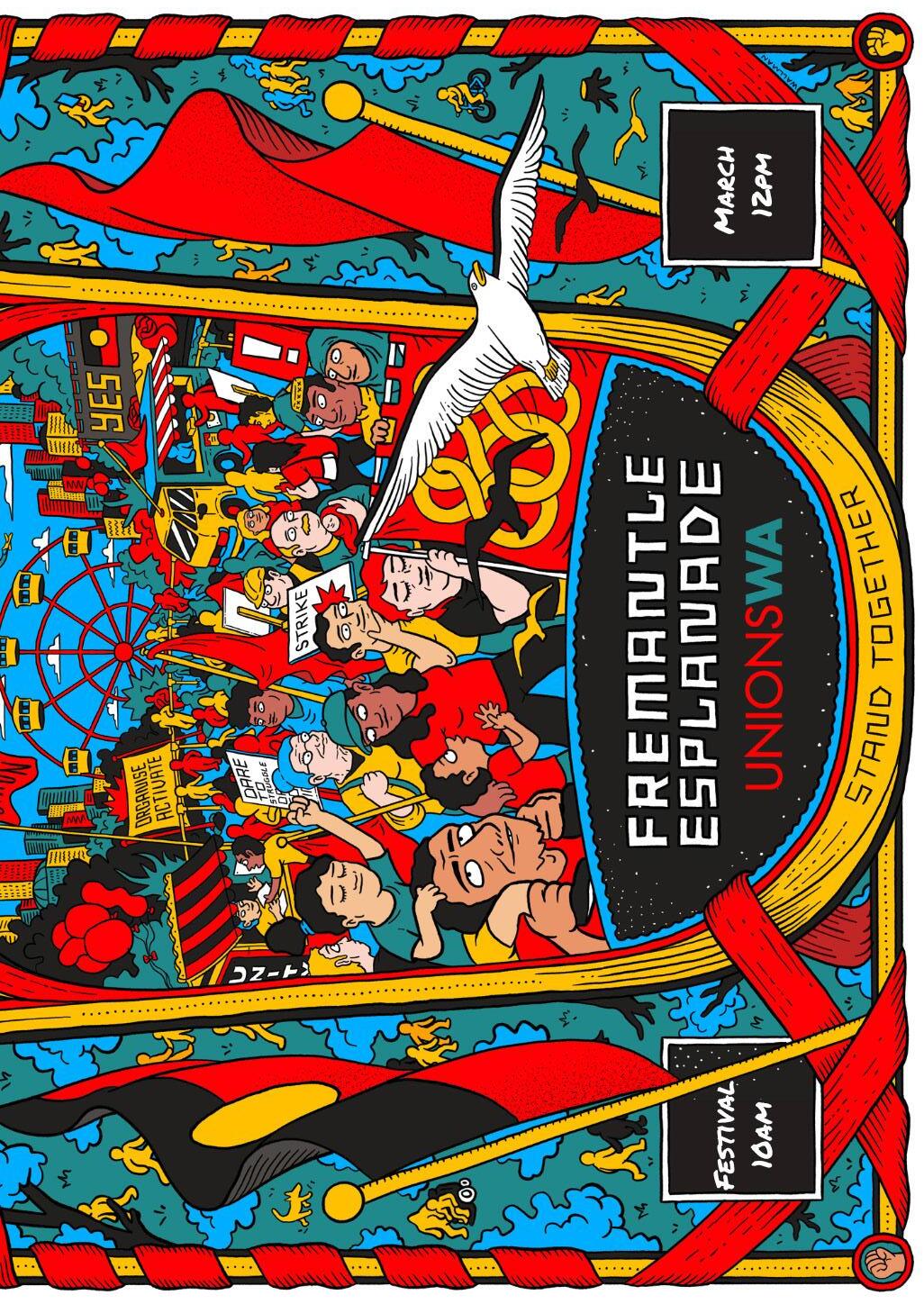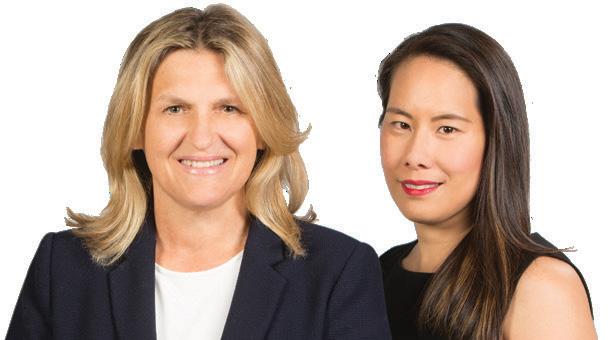sstuwa
Read more on pages 11-13
sstuwa.org.au










































Read more on pages 11-13
sstuwa.org.au









































Correspondence:

The Editor, PO Box 212, West Perth WA 6872
editor@sstuwa.org.au | Ph: 9210 6000
Member Assist:
Ph: 9210 6060
memberassist@sstuwa.org.au
Print post publication 100004470 | $4.95
ABN: 544 780 946 35
Authorised by Mary Franklyn, General Secretary, The State School Teachers’ Union of W.A. (Inc.) 1 West Street, West Perth WA. Printed by Vanguard Press, 26 John Street, Northbridge WA. April 2023.
Cover: The AEU has affirmed its commitment to the Yes campaign for the referendum on the First Nations Voice to be enshrined in the Constitution. Read more on pages 11-13.

To access the digital copy of Western Teacher, visit: sstuwa.org.au/westernteacher
Advertisements in Western Teacher are the responsibility of advertisers. While Western Teacher makes reasonable efforts to ensure that no misleading claims are made by advertisers, responsibility is not accepted by The State School Teachers’ Union of W.A. (Inc.) for statements made or the failure of any product or service to give satisfaction. Inclusion of a product or service should not be construed as an endorsement or recommendation by The State School Teachers’ Union of W.A. (Inc.)
is the official publication of The State School Teachers’ Union of W.A. (Inc.)
We wish to acknowledge the traditional custodians of the land on which we live and work. We wish to pay respect to their Elders – past, present and future – and acknowledge the important role all Aboriginal and Torres Strait Islander people continue to play
and Ait Koedal artist/designer and former WA public school student. Read more about the artist and the artwork at



The latest results from the annual Australian Principal Occupational Health, Safety and Well-being Survey are of great concern and highlight the strain school leaders are under as they struggle to manage the ever-increasing workloads, demands and expectations of their jobs.
More than 2,500 school leaders were involved in the 2022 iteration of the survey, which revealed a rising level of stress stemming from dealing with issues such as staffing shortages, health and well-being; student mental health issues; unreasonable workloads and community expectations of their role.
Rates of bullying, threats and actual incidents of violence were on the rise, too, and over half of the WA school leader participants are showing a risk of mental and physical burnout.
The survey specifically found:

• More than half (55 per cent) of WA school leaders were subjected to threats of violence.
• The same figure (55 per cent) were subjected to physical violence.
• Fifty-two per cent of WA school leaders had received a “red flag” alert email, up from 28 per cent in 2021.

• The percentage of school leaders encountering physical violence and cyberbullying is at its highest rate since the first survey 12 years ago.
Furthermore, the survey listed the following as the top five sources of stress for school leaders:
• Sheer quantity of work.
• Lack of time to focus on teaching and learning.
• Teacher shortages.
• Mental health issues of students.
• Mental health issues of staff.
According to the survey, 65 participants revealed they were planning to quit or retire early in 2022, which was triple the figure from only three years back.
One female school leader from NSW commented: “I am leaving earlier than expected due to stress, the sense of frustration at being moved away from educational leadership and into management conversations, parental concerns, staff fatigue and my own burnout.”
I have seen and personally experienced some of these stressors firsthand and sadly, many school leaders will not be shocked by these findings. They are a sad and disturbing indictment on the flaws within the system.
It highlights the urgent need for educational authorities and politicians to listen to the profession about their concerns, about what needs to be fixed and to work with them collaboratively to do so.
For government it is instructive that the cost of living payments did not have the desired impact to help retain nor attract school leaders if the last 12 months of vacancies are anything to go by.
The SSTUWA has been sounding the alarm on these issues for many years and the desire to effect change has seen the union commission its independent review of public education.
The review’s expert panel has already held many consultations sessions in metro and regional locations across the state and we are calling for more review submissions from all interested parties.
It is important for all of those who have a stake in public education to let us know about just how these issues, and countless others, impact on schools, students and educators.
We want to be able to take these findings to the state government so that real, effective and lasting change can be secured for the betterment of the sector, those who work in it, and ultimately the students who learn in it.
For more information about how to send in your submission visit sstuwa.org.au/review
The closing date for submissions is 21 April.
The SSTUWA congratulates the New South Wales Teachers’ Federation (NSWTF) for its strong campaign on public education over the past few years, culminating in a strong presence during the NSW election campaign.
The federation made education a key factor in the state election and the result is a testament to their hard work.
The NSWTF has secured significant pledges from the incoming state Labor government, including a promise to bring funding for state schools up to 100 per cent of the minimum school resourcing standard.
We are well and truly underway into the year.
As you would have seen, your union has commissioned an independent review into the current state of public education in WA.
The SSTUWA Review of Public Education, chaired by former premier and education minister Carmen Lawrence, will not only identify the current issues impacting on our public education system in WA, but also look at the much needed practical and realistic solutions.
Some of the factors the review will examine include the effect of state government policies on schools, the impact of Covid-19 and changes in reporting, community expectations, respect for the profession and accountability.
They will also look at new research with existing research the SSTUWA had already undertaken in recent years.
We need this review to drive the push to elevate the status of public educators and ensure the sector receives the full resourcing that it needs.
It is a process that will involve working with the new education, training ministers, the state government and the Department of Education.
Meetings with key groups in the education community have been set up with members of the review team.
We know from our membership that teachers and school leaders have never experienced such serious challenges in our educational settings, and the impact of these can be felt in all part of our sector, including TAFE.

The review team wants to listen to the members of the community. This

includes our First Nations voices, parents, education assistants, school boards and other associations.
We urge you to encourage all of these groups to participate in the review.
The public education review team have been attending District Councils and consultation meetings (see pictured) to discuss why this independent review into public education in WA is so needed.

While this part of the process is drawing to a close, there is still time for you to have your say by entering submissions to the review via the website.
You can make a submission individually, as a union branch or as a school. The deadline for submissions to the review is 21 April.
For more information, including the terms of reference regarding the review and how to respond, go to sstuwa.org.au/review
You and your communities know more than anyone else the changes that have occurred in WA.
These are the everyday and long-term issues that affect your students, your colleagues and your workplace.
They are the issues that if addressed, can propel public education and our profession forward.
If ignored they are the same issues that will place a bind on the betterment of the system and those who teach, lead and learn within it.
It is vital that you have your say.

Not long to go now until the school holidays are upon us. Make sure you take some time to rest, recharge and recover after what has been an extremely busy start to the 2023 school year.

As noted by SSTUWA Vice President Sharmila Nagar on the previous page, the deadline for submissions to the independent review into public education is drawing near.
Whether you are a principal, deputy, head of learning area, senior teacher or Level 3 Classroom Teacher, you are in a unique position to offer insight into the challenges public educators face on a daily and long-term basis.
It is vital the panel capture what the critical issues facing public education are and explore possible solutions. As such, I would implore all school leaders and senior staff to take this invaluable opportunity to provide the panel with your input on the state of the sector.
The results of the review will help to inform and educate the broader community and government about what needs to be done to deliver a top-class education system – and the best way for you to assist is to get involved, as you see more than most, the really pressing issues affecting public education.
The latest results from the Australian Principal Occupational Health, Safety and Well-being Survey (see page 5) further underline the urgency for reform for school leaders in terms of their workplace conditions and career pathways.
The panel would love to hear from any school leaders who have feedback in those areas, too.
Visit sstuwa.org.au/review for more information and for the opportunity to have your say. Submissions close 21 April.
Dealing with incidents that affect schools such as floods and fires can consume many hours of a school leader’s time, but if you ever find yourself in that situation, the SSTUWA has secured some relief for you.

One of the major achievements from the last Schools General Agreement was winning compensatory leave for principals.
Under GA 2021 Clause 17.8:
a) The intention of compensatory leave for principals is to provide recognition of work required to be undertaken outside of normal school hours to manage catastrophic emergencies and events.
b) Compensatory leave for principals is not for circumstances normally met by other forms of leave.
c) Compensatory leave for principals is not approved for work done on tasks that are normally completed by others.
d) The Department will credit Directors of Education with 320 days of compensatory leave across all regions for Principals over two years.
e) Compensatory leave for principals can be approved for part of a day.
Applications for compensatory leave for principals need to be made to the Director of Education as soon as practicable, and if approved, will be taken at a mutually convenient time.
This was a national first and a core achievement from the GA 2021 that you, by being part of a powerful collective that is the SSTUWA, helped to achieve.

With Western Australia’s public education system currently facing a teacher shortage, among other issues, the unfortunate reality is that schools in regional and remote areas are the worst affected.

While it is tough to find experienced, fully qualified teachers to teach specialist subjects in metropolitan schools, it’s far more difficult to attract those people to country schools.
As a result of the shortage, the SSTUWA is aware regional schools are having to amalgamate classes so that several year groups are in one class; a challenge for an experienced teacher, let alone a graduate or new teacher who’s unlikely to have access to enough support.
The absence of system provided professional learning to help differentiate the curriculum only compounds this challenge for country teachers.
A record number of regional students are having to turn to the School of Isolated and Distance Education (SIDE) to do particular subjects which aren’t available at their local school primarily due to the teacher shortage, or the school cannot fund a particular course.
The online learning environment is now a regular part of a regional secondary student’s timetable and a troublesome, logistical reality for regional school leaders and teachers.
And while the challenge of attracting experienced teachers to the regions is nothing new, a series of policy decisions and other factors have made it even harder for regional schools in recent times.
The introduction of the Independent Public School (IPS) model by the Barnett Government was designed to give schools more independence in how they managed their budgets and staffing.
Unfortunately, one of the predictable consequences was the removal of incentives for teachers to go to the regions. For example, working in a regional school for a length of time previously made teachers eligible to choose their preferences if they decided to return to the metro area. That incentive was removed as part of the IPS system.
The availability and standard of Government Regional Officer Housing (GROH) has also had a huge impact on the attraction and retention of staff in regional areas, with teachers unable to find anywhere suitable to rent.
The SSTUWA is aware of a growing number of smaller country shires who opt to build their own school leader or teacher accommodation, given the quality offered by GROH.
We are yet again seeing reports of
property prices and rents soaring across regional WA, making the market almost inaccessible for teachers, particularly in mining towns.
Teachers not identified as “local” by Department of Education policy are the first to be impacted by high rental costs in regional locations.
This shows exactly why GROH should have been properly funded, rather than abandoned to the market. Again, a previous government started this process, but the current one has not adequately addressed the issue.
Our members also tell us their workloads are at unsustainable levels, with teachers in the regions more likely to have to take on extra administration or cleaning duties due to a lack of staff in their school.
Combined with the constant erosion of regional support networks, this leaves school leaders and teachers feeling isolated in more than just the geographical sense.
When the base model for funding public education was developed – a system called the School Resourcing Standard (SRS) – the extra needs of vast states like WA were recognised by a recommendation that the state get a minimum of 105 per cent of its SRS figure. Nowadays WA public schools get 91 per cent.
Full SRS minimum funding would equate to around $1,800 for every state school student. The impact on education would be enormous and could be targeted according to a particular school’s needs – more specialist subjects (including ATAR courses) with suitably qualified teachers, smaller class sizes, better IT and more support for students with particular needs.
The challenges being faced by regional and remote schools is one of the reasons the SSTUWA has commissioned an independent review of the public education system.
The expert panel has been travelling around the state to hear directly from people in the regions about the problems they’re facing in schools.
The review panel will report back to the union later this year, and we expect it will provide some recommendations on how to attract more teachers to regional schools and improve education for our regional kids.
The SSTUWA recently discovered that a regional TAFE college had been unlawfully demanding repayment of the initial cost of moving to the regional location from employees who resigned prior to completing two years of service.
The college in question relied upon an internal policy requiring repayment of their initial move to the region and had employees sign an agreement about the policy to receive their owed entitlement.
The college later sent an invoice to at least two SSTUWA members seeking reimbursement of part of the removal allowance.
The SSTUWA insisted the college withdraw the demand for payment and remove the offending provision of the policy on the basis that:
(a) The removal allowance is an entitlement under subclause 76.1 of the TAFE Lecturer’s General Agreement 2019 (TAFE Agreement);
(b) The policy contravened the Industrial Relations Act 1979 (WA) because it required employees to repay an entitlement under an industrial agreement, which amounts to contracting out contrary to section 114 of the IR Act.
 By Mario Schmidt and SSTUWA Legal Services Team
By Mario Schmidt and SSTUWA Legal Services Team
The college agreed with the SSTUWA’s position and withdrew the demand for payment from the two members in question.
It subsequently conducted an audit going back to 2015 and as a result, reimbursed 11 employees.
The college assured us they would no longer enforce the offending provision under the current policy and plans to publish its new policy in 2023.
We are now working to identify any other members who may have repaid any removal allowance amounts believing the policy was lawful.
Although the college in question has carried out a review to identify and rectify any previous situations where members repaid the allowance, there may be members in other colleges who are affected by a similar policy or whom the review did not identify.
If you have been asked to repay, or have repaid, removal allowance or another entitlement under the TAFE Agreement, we ask that you contact Member Assist or your TAFE organiser as soon as possible.
We will raise this directly with your employer to seek rectification, and if that is unsuccessful, refer the matter to the SSTUWA’s Legal Services Team for action.

Last edition, we outlined your graduate allocations: the allowances, release time and professional development that you are entitled to as a graduate teacher. But how aware are you, of the other supports available to you?
If you are in your first 30 months of teaching and have completed Graduate Module 1, you can request to join the In-Class Coaching Program (ICCP). You will be allocated a teaching and learning coach from Statewide Services who will meet with you regularly for confidential, non-judgemental coaching.
This is fantastic for building the skills of reflective practice and very helpful for transitioning to full registration, as well. What’s more, this program is provided entirely free of charge.

You can apply for this program through Ikon by searching for ICCP or contact the team at Statewide Services via email: InClassCoachingProgram@education. wa.edu.au


Did you know that, under the new 2021 General Agreement (Clause 25.4), the use of graduate teachers for internal relief should be by agreement with the graduate teacher?
This is in recognition of the additional workload for a brand-new teacher navigating much of the work and processes of teaching for the first time.
As a graduate teacher, it’s important to be proactive about this entitlementmake a time to discuss your availability for internal relief with your principal or relief coordinator as early in the school year as possible.
If you have any questions or concerns about your working conditions, you can call Member Assist on 9210 6000, Monday-Friday, 8.30am-4.30pm or email memberassist@sstuwa.org.au
Another strong resource is your workplace branch. If you aren’t sure who your union rep, deputy rep and women’s contact officer are, ask around or give Member Assist a call. Attending branch meetings and speaking with other members is a powerful way to support your rights in your workplace.
For low-cost, high quality professional learning, check out the union’s Education and Training Centre. As an SSTUWA member, you receive discounted rates on professional learning courses, available in both face-to-face and online formats, and are eligible for up to five days of Trade Union Training leave each year to attend selected industrial courses. Visit sstuwa.org.au/training for more information.
You’re already here reading our new educator article in Western Teacher. Don’t forget to also check out the NENews, sent to your inbox each month.
For more regular support and advice, free online professional learning and networking opportunities, join the New Educator Network – WA on Facebook.
If there are a number of new educators in your school, you can arrange a visit from the SSTUWA Growth Team by emailing neweducator@sstuwa.org.au
We will be available to visit staff at morning tea and lunch, bringing information and materials related to new educators.

The Australian Education Union (AEU) has affirmed its commitment to the Yes campaign for the upcoming referendum on the First Nations Voice to be enshrined in the Australian Constitution. The announcement was made at the 2023 AEU National Conference in Melbourne.

AEU Yalukit Yulendj (National Aboriginal and Torres Strait Islander Education Committee of the AEU) chair Russell Honnery told union delegates, political leaders and the media at the conference that it was a historic moment that symbolised the first step towards Australia’s reconciliation with its past.
“In 2017, Aboriginal and Torres Strait Islander people gave Australia the gift of the Uluru Statement of the Heart and in 2018, the AEU and other education unions endorsed it,” he said.
“Today, we ask you to walk with us to support the Voice to Parliament.
“The United Nations Declaration of Rights for Indigenous Peoples, article three says, ‘States shall consult and cooperate in good faith with Indigenous
peoples concerned through their own representation institutions in order to obtain their free, prior consent.’
“Aboriginal and Torres Strait Islanders have continually called for representation in decision making about their own affairs. This year, 2023 is the time to finally make this happen in Australia.
“The three fundamental changes - Voice, Treaty, Truth - are all parts of the Uluru Statement of the Heart, with Voice being the first reform. A Makarrata Commission will then support the process of Treaty and Truth.”
AEU Federal President Correna Haythorpe said that the AEU would work in consultation with Yalukit Yulendj to educate members and the broader community on the significance of the Voice to Parliament.
“Our union, which consists of public school, preschool and TAFE teachers, principals and support workers, overwhelmingly backs in First Nations Australians and their call for selfdetermination through constitutional reform,” she said.
“That’s why the AEU endorsed the Uluru Statement five years ago and that is why we extend our unstinting support to the Yes campaign today. And, that is why we will back this in with resources including a Voice campaign lead officer and project officers.
“For too long, Aboriginal and Torres Strait Islander people have been ignored or had little opportunity to have their say about the policy and decision-making processes that impact their families and communities.
“The Uluru Statement from the Heart stated that a First Nations Voice to Parliament must be the starting point in ensuring that First Peoples get a say in the decisions that affect their lives and the lives of their communities.
“We cannot allow this critical opportunity to move forward towards reconciliation slip away from us. It is time to right the wrongs of the past and unite all Australians.”
On Thursday 23 March, Prime Minister Anthony Albanese announced the wording of what will be proposed in the referendum to change the constitution and recognise Aboriginal and Torres Strait Islanders as the First Peoples of Australia.
In doing so, it recognises our country will be stronger, more productive, fairer and strengthened as a nation by establishing a Voice to Parliament on matters pertaining to us.
We implore you to support this proposal and join us with a Yes vote. The referendum invites you to recognise our unique history and connection to the world’s oldest living culture and allow Aboriginal and Torres Strait Islander peoples to be part of the decision making on matters that pertain to us.


The proposed amendment to the Australian Constitution to recognise First Peoples and support for a voice for the referendum reads as “A Proposed Law: to alter the Constitution to recognise the First Peoples of Australia by establishing an Aboriginal and Torres Strait Islander Voice. Do you approve this proposed alteration?”

This supports the formation of a body that engages the Aboriginal and Torres Strait Islander voice to have the ability to make representation to Federal Parliament and the government of the day on matters relating to us. The Parliament subject to the constitution will establish its composition, functions, powers and procedures.
The Prime Minister described why it matters and what it will achieve, stating that it is “common courtesy and decency to ask people before you take a decision that will have an impact on them ... because when you reach out and listen to communities you get better results. It won’t take decision making power away from the government or Parliament, but
it will help governments and parliaments make better decisions and achieve better outcomes. And we urgently need better outcomes.”
The Uluru Statement from the Heart was released to the Australian people six years ago, and as the Referendum Working Party stated, this opportunity has been years in the making and represents a big step forward on a long journey of constitutional recognition.
Megan Davies, chair of the Uluru Statement, implores all Australians to unite behind us and walk with us in a movement of the Australian people for a better future.
The final wording was the result of consultation with the Referendum
Working Party and the government and the invitation is extended to all Australian people.
Pat Dodson explains it requires all Australians, “so that we as Australians can arise to a better relationship with our First Peoples”.
As educators we have an important role to ensure we are educating our students and staff in a balanced way.
It is our responsibility to be informed and understand what the referendum is about and what it means for Aboriginal peoples and the kind of relationship with us you want moving forward.
It asks you to understand how past government policies and practices have impacted us intergenerationally in negative ways because we haven’t been part of the decision-making process.
Our voice has been ignored in those arenas, and we are asking you to help us reconcile as a nation and move forward by empowering us to be decisionmakers in policies and programs that target us.
We have always known the power of building positive working relationships with Aboriginal people in our schools.
Ensuring that an Aboriginal family’s aspirations are reflected in school directions and students’ achievement have yielded the strongest outcomes. But governments change, and so does the political will.
This is too important to keep changing. As surmised by Thomas Mayo from that referendum working group: “we want this to be above politics, we are tired of having our lives used as a political football.”
Past practices such as ASSPA Committees, School Community Partnership Agreements, Aboriginal Advisory Councils all reflect the journey we have been on in ensuring the voice of our parents is reflected in the priorities and actions of schools and systems, but all have faded away with change of governments.
Enshrining our voice in the constitution is the only way to stop this and ensure we have a voice in our affairs and move forward as a reconciled nation.
We ask our members within the SSTUWA to walk with us and as educators, we are informed and accept the invitation that is at the heart of the Uluru Statement that specifically calls for a voice enshrined in the Australian Constitution.


This request has come after decades of activism by our people who have fought for a fair go and say in our own communities and in our own affairs.
We urge you to vote Yes.
From the SSTUWA Aboriginal and Torres Strait Islander Education Committee.

ChatGPT and its powerful capacity to generate original text has taken the education sector by surprise. Not only are universities hurrying to adapt to it, schools are also grappling with this new technology.
New South Wales and most other states blocked the tool in public schools, to protect students from possible misinformation and curb cheating. But South Australia has allowed use of ChatGPT, in part so students can better learn and understand the potential and risks of artificial intelligence (AI).
The range of responses to ChatGPT shows how education has yet to figure out the best way to use such tools.

ChatGPT is also just the latest example of technology coming into classrooms. Education technology (or edtech) is a common – and rapidly growing – part of day-to-day learning. But we need to understand it better.

The global edtech market is estimated to be worth about US$300 billion (A$432 billion). More than one billion students globally are expected to use edtech by 2025. Google and Microsoft are major players, but investment is also increasingly fuelled by China, India and the European Union.
Edtech includes teaching support platforms, with sample lesson plans, tasks, games and tests. It also includes AI-backed personalised learning tools to help with maths, literacy and other school subjects. As of 2019, Australian teachers were using an estimated 250 different types of edtech, although there is no reliable number of how many use AI.
We already know some of these edtech
tools are having positive results, including in disadvantaged areas. Studies suggest adaptive tutoring, which adjusts to the precise needs and level of the individual student, is especially promising.
Edtech also allows for more personalised assessment. As students move through a lesson answering questions, they can automatically get feedback, find additional instruction and branch into easier or harder content as needs be. Most importantly, teachers get detailed insight to student progress that allows them to adjust their teaching to better match what students need.
But despite these advancements, we also know edtech delivers the best results when the tools are based on proven teaching techniques. Poorly designed tools also can undermine education. In the United States (US), national funding laws now push school districts to make sure edtech and other teaching tools are independently evaluated for positive impact.
There are significant risks to these tools as well, especially around privacy and the marketing of student and teacher data collected when they use the tech. These risks increase if autonomous AI is behind the tool.
With a rapidly expanding edtech market, it’s easy for teachers and parents to be confused about what’s on offer, how to use it and whether it will help students learn.
ChatGPT highlights how quickly products are emerging and how quickly education systems will need to respond. We need governments to be shaping what and how technology is used in classrooms to ensure high quality, safe products and avoid being caught by surprise.
Globally, some steps are underway. The European Union has adopted a comprehensive digital education plan, the US has created a dedicated national
edtech office, and the United Kingdom and Singapore want to use edtech to tackle specific learning needs.
Australia also needs to ramp up government leadership in managing the opportunities and risks that come with this edtech. This includes:

• Quality requirements for the tech itself – including evidence it is based on education research.
• Professional learning and support for schools and teachers using it.
• Regulation and transparency around how student data will be collected, stored and used.
Independent websites in the US are also helping schools and families find highquality learning resources (including digital tools). For example, EdReports
assists teachers to evaluate curriculum materials, while Evidence for ESSA reviews the quality of research behind claimed edtech impact.
A growing body of research shows that high-quality education technology can be a powerful tool to improve student outcomes, particularly for students facing education disadvantage.

But not all edtech tools work well and much depends on how schools use them.
The most important impact of ChatGPT may be to galvanise governments and education systems to ensure Australian schooling can proactively and properly use edtech in our classrooms.
The next National School Reform Agreement offers the perfect opportunity to do this. This agreement ties federal, state and territory funding mechanisms to lifting student learning outcomes. It is currently being negotiated and is due in December 2024.
It is important we use the opportunities provided by edtech, rather than edtech using us.
Leslie Loble is an Industry Professor and Paul Ramsay Foundation Fellow at the University of Technology Sydney. The opinions expressed in this article are those of the author and do not necessarily reflect any official policies or positions of the AEU or the SSTUWA. This article was first published on the Conversation website and has been reproduced here with permission.
The WA Department of Education (DoE) moved to ban access to ChatGPT in schools at the start of the 2023 school year.
The ban prevents access to ChatGPT from DoE servers and devices and has been put in place to prevent students submitting work generated by artificial intelligence (AI) at school.
The ban cannot prevent students from accessing the controversial tool outside of school.
DoE director general Lisa Rodgers told media that teachers would be able to distinguish or identify work submitted by students that used the AI tool.
“Teachers know their students and their level of capability, and also the types of things that they would write about and the position they would take on issues,” she said to The West Australian newspaper.
Teachers are not banned from using the tool outside of the school either, with Ms Rodgers acknowledging their usefulness in generating teaching resources.
“We can’t stop what people are doing outside of school, so teachers might [as] well use ChatGPT,” Ms Rodgers told the newspaper.
“They are going to put together resources that best meet the needs of their students.”
At time of press educational authorities in Western Australia, New South Wales, Victoria, Queensland and Tasmania have banned the use of AI such as ChatGPT.
South Australian schools have allowed the use of AI, but not for graded work.
“It can’t be used for exams, and when students are graded the technology is already in place to be able to prevent that, we’ll do that,” SA Education Minister Blair Boyer told ABC News.
“But I think we need to find a way of having it embraced to an extent that we can teach kids the upsides, the pitfalls, how to work with it and also focus on the things that our graduates will be able to do that artificial intelligence can’t do.”
The story of the State School Teachers’ Union from its inception is a story well worth the telling.
It’s a story of many trials and vicissitudes. It’s a story of incredible achievement in the face of much official and teacher apathy.
It’s an occasional story of organised opposition in high places. It’s a tale of success in the very best traditions of industrial organisations.
And it’s also a tale of contribution to educational advancement in an area about half the size of Europe.
It’s important to realise at the beginning that the birth of a teacher organisation in Western Australia was no accident.

Rather, it was a predictable response to a felt educational and State need.
In retrospect, we can see that there was a proper time and place for this particular birth, conceived by changing historical, geographical and economic forces.
This period, when the state achieved responsible government, was a time when the whole population was geared to advance, educational advance amongst others.
Confidence in the community was unbounded. The famous
AtholMacGregorremainedanactiveunionistallhislife.
Inthe1920strike,hewasamemberoftheDisputesCommitteeandoneofitsjointtreasurers. Heretiredin1927and wasmadeaLifeMember.

Onhisdeathin1960,NoelSampson,whohadbeena pupilatHighgatewhenMacGregorwasheadmaster,saidof him:"Inhistime,MrMacGregorwasamanofgreatrepute inWesternAustralia. Hehadwideinterests. Nonewasmore ATHOL E. J lllscGREGCR highlyrespected.
JOSH HAMMILL, foundation Secra!tar-. of the Union, was a South Australian, w•c trained in Adelaide as a pupil teacher �:'ore graduating from Adelaide Teachers College.
Attheageof24hecametoW.A.ancfrco 1896until hisretirement·in1932taughtonly�--H:gh;;ak NxthPerlh andVictoriaParkschools. HammillservedtheUnioninmanyp:ist,.


 By A.E. Williams
By A.E. Williams
Amongst the many migrants were men of discernment and learning; some imbued with new industrial thinking. From some of these in future months came the original impulse which led on to the establishment of our union. Others followed.
The development of a teacher organisation in this state was a development which was overlong in coming. There are critics who complain today about the pace of educational advancement. There always will be such critics.
But what these critics often overlook is the tremendous difficulty in establishing our educational foundations in the first place - foundations which we now take for granted.
When in difficulties, our teachers always find our union an unfailing source of strength and endeavour. But it had to be begun; it had to win its spurs as a respectable establishment; it had to be proved and tried and its undoubted powers forged in the fires of argument and faction before it became that honoured instrument which we admire today.
To anyone who queries the value of our union there is a simple answer: Can you imagine the educational set-up of Western Australia today without it?
This an excerpt from an article originally published in the 22 February 1973 issue of Western Teacher to commemorate the SSTUWA’s 75th anniversary. It has been edited for brevity and clarity.
control. Responwasachieved CabinetMinDepartmen1 Andthisdevelunnaturally, was yearbythe collectiveteacherourTeachers'
JOSHUA HAMMILL




 By Rachel Wilson
By Rachel Wilson
The ROGS report from the Productivity Commission (PC) is the fourth in a row making important insights on where Australian education has gone wrong.
The data for the Report on Government Services (ROGS) made it clear that Australian school funding is iniquitous.
While this fact could have been called out on any day in the nearly 11 years since the Gonski report was released, the data establishes it authoritatively.
Previous low-key reports by the National School Resourcing Board and National Audit Office have highlighted the lack of transparency and accountability evident in funding arrangements.
Earlier, the PCs interim report for the quinquennial productivity review in October last year put education issues front and centre of economic concerns and provided a warning bell for their interim report on the National School Reform Agreement (NSRA). Both clearly assert “Canberra, we have a[n education] problem”.
These three identify the threat that arises from our current educational woes and make it clear that there are system structural and transparency faults contributing to our difficulties.
But it is the PCs report on the National School Reform Agreement that provides a fuller analysis of our education system, importantly identifying deeply entrenched system level faults.
Headlines on the NSRA report squealed “Call for focus on teaching as academic results slide despite $300b school funding deal” and “Still lessons to be learned to improve student outcomes”
suggesting the problems resided with teachers, in classrooms.
Social media comments were along the lines of “please save us from another report telling us how bad Australian education is” and from teachers: “the start of school year whinge about teachers”.

However, the 350-page NSRA report is not just another highlighting the long litany of stagnation and declines in Australian education.
I would encourage all education researchers to read it, but for fans of Blinklist, I provide a synopsis and explain why.
Let’s start at the beginning. The report was designed to examine and evaluate “the effectiveness and appropriateness” in the national school reforms; and “the appropriateness of the National Measurement Framework for Schooling in Australia (NMFSA)”.
On the reforms a report card is provided in the main report but not the summary report (perhaps this is why the headlines went awry?).
This report card rather optimistically claims that four out of seven initiatives have been achieved. Reflecting on this, I can’t help but wonder what a 3/7 scorecard for a school principal would lead to?
In this case, despite investing $319 billion, key initiatives remain virtually untouched.

The tick against the national teacher workforce strategy seems overly positive, particularly as the National Teacher Workforce Data set is currently incomplete, with only approximately 10 per cent of Australia’s teachers included.
So too the report of “partial” outcome assessment in improving national data quality. As the report goes on to show, the NMFSA data is far from ideal, not
aligned to national education goals, and poorly reported on.
If you’re not a fan of educational data please don’t turn away now. You may have been put off by the data we currently have and the focus on how schools will work with it, but data is fundamental to system monitoring – and here is where the core of the problem lies.
The report goes on to conclude:
• The Agreement’s outcomes and targets were incomplete.
• Reform activity has at times lacked focus and flexibility.
• Reporting and transparency arrangements have not had bite.
There may be some bureaucratic euphemism here. On my reading of the situation there were no specific targets, many reforms were not achieved, and reporting and transparency was virtually non-existent.
Still, there are some lessons to be learnt for future reform agreements, namely:
1. Parties should focus the next school reform agreement on directly lifting student outcomes.
2. Adapt accountability mechanisms

to reflect a greater role for statespecific actions.
In other words, if there is to be any hope of improving the situation, we need to focus on clear goals for students – and make the system/s accountable.
I have to agree. After all, teachers have been facing accountability pressures for some time and often face the brunt of blame for poor educational outcomes.
From my own research perspective, listening to teachers, I can see much current frustration in Australian education boiling down to the old expression “what’s good for the goose is good for the gander”.
Frequent calls for teachers to lift teaching quality, be more evidencebased in their practice, must be matched by evidence-based policy.
We need more data, transparent reporting and critical system analysis to identify the structural problem at the heart of our current woes.
We need an education system designed for purpose that can pursue the educational goals we have agreed to. And we need upward as well as downward accountability in order to serve students, citizens and society.
(Continued on page 22)
(Continued from page 21)
Nicole Mockler’s analysis of media suggests the dominant refrain is “we have a teacher problem” but much relies on system architecture, like the NMFSA, where we evidently have some challenges.
Furthermore, there is little evidence to support the assertion that teacher/ teaching quality is a problem.
Our system data is simply inadequate to support that assertion. We don’t have adequate data on who and where our teachers are in order to address teacher shortages, nevermind data telling us what they do and how effective they are.
The report goes on to examine some of the dynamics between poor monitoring of educational equity, rising issues with student wellbeing and problems, work demands on teachers and teacher shortages. It makes for sobering reading.
In its evaluation of the NMFSA the report concludes:

“The Measurement Framework for Schooling in Australia (MFSA)’s Key Performance Measure (KPM) dataset has reporting gaps against the National School Reform Agreement (NSRA) performance reporting framework, particularly on outcomes for students from priority equity cohorts. “
In fact, as the submission from the Centre for Educational Measurement and Assessment makes clear, very little of the data is aligned to national educational goals.
Furthermore, there is inadequate monitoring and reporting on the data available – resulting in poor transparency on how our system is performing, and where trends are heading.
This is particularly the case with educational equity, which is declining, but is not effectively monitored by government reporting.
The outcomes for some equity cohorts, like students with disability for example, are completely ignored in the National Report on Australian Schooling.

The PC NSRA report agrees and concludes:
“The NSRA has an accountability deficit. In addition to the MFSA not being wholly relevant and complete as a tool to measure progress against the Agreement sub outcomes, visibility of governments’ progress is diminished by the absence of standalone reporting.”
These seem like sensible recommendations. Equity, in tandem with excellence is, after all, our number one education goal.
It seems logical we should focus on it, monitor and report on it. Only then can we hope to target money and resources accurately and efficiently to minimise inequity.
The key to building equity naturally
requires a focus on students, not only what they learn but how they feel.
Broadening educational goals, and data, to value and monitor student wellbeing is a no-brainer.
And no progress can be made without supporting teachers. Addressing structural and system accountability problems, including poor data, inadequate monitoring for reasonable targeting of funding and resources, poor professional workforce management, will make teachers’ working lives in schools much easier and productive.
This is a watershed realisation in a government report, an acknowledgement that it is the system, not teachers, that is failing. That is a good start.
Rachel Wilson (Twitter: @RachelWilson100) is an associate professor at The Sydney School of Education and Social Work at the University of Sydney. She has expertise in educational assessment, research methods and programme evaluation, with broad interests across educational evidence, policy and practice. She is interested in system-level reform and has been involved in designing, implementing and researching many university and school education reforms. The opinions expressed in this article are those of the author and do not necessarily reflect any official policies or positions of the AEU or the SSTUWA. This article was first published on EduResearch Matters blog (aare.edu.au/blog) and has been reproduced here with permission.
 By Trevor Cobbold
By Trevor Cobbold
Some of the commentary on the Productivity Commission (PC) report on the National Schools Reform Agreement (NSRA) has drawn a simplistic and highly misleading link between increased school funding and results.
It ignores the key facts that Catholic and independent schools had the largest funding increases since 2009 and the largest declines in international test results.
The figures suggest that private schools are much less efficient than public schools, especially given that public schools enrol the vast majority of disadvantaged students.
The report triggered a severe bout of wailing that funding increases over the past decade have failed to have any impact on school outcomes.
A headline in the Australian Financial Review said it all: “Gonski billions had ‘little impact’ on literacy, numeracy”. It editorialised: “Spending so much money to produce so little in the national interest raises questions about the basic effectiveness of public policy”. Many others took up the refrain.
The wailing was helped along by the PC itself. Commissioner Natalie SiegelBrown told the Sydney Morning Herald: “Governments have boosted funding for schools and are implementing reforms to lift student outcomes. However, so far, this effort has had little impact on literacy and numeracy results.”
This was despite the PC’s own statement that funding was outside the scope of its inquiry. The report itself did not draw such a link.
It did not analyse the relationship between funding and school outcomes. Yet, the commissioner went ahead and fuelled the mantra that funding increases have failed to improve outcomes.

It was enough for the Financial Review to claim that the PC had “shockingly concluded” that the Gonski funding had failed. The report did not make such a finding or conclusion.
The Financial Review’s comments are a common mantra. They are simplistic and superficial. They fail to analyse what has happened to school funding and outcomes over the past decade or more.
A more thorough analysis shows that funding increases have heavily favoured private schools which enrol only a small proportion of disadvantaged students and that private schools had the biggest declines in international test results.
First, the mantra fails to acknowledge that the biggest funding increases have gone to private schools and they have far more resources than public schools.
On average, private schools are over-funded while public schools are massively under-funded.
The funding increase for Catholic and independent schools since 2009 was three times that for public schools.
Since 2009, Commonwealth and state government funding per student, adjusted for inflation, increased by $830 per student in public schools compared to $2,839 per student in independent and $2,490 per student in Catholic schools.
Private schools now have an even larger resource advantage over public schools.
(Continued on page 24)
(Continued from page 23)
The average income per student in independent schools in 2020 was 52 per cent higher than for public schools − $24,338 per student compared to $16,030 per student in public schools.
Income per student in Catholic schools at $17,831 was 11 per cent higher than in public schools.
The mantra regularly disparages the Gonski funding as having failed. In reality, there was very little Gonski funding.
The additional funding in the first four years of the plan was little more than planned in the forward estimates at the time.
The big funding increases planned for the last two years never eventuated. The Abbott Government abandoned the $7.5 billion funding increase planned for last two years of the plan.
It also immediately abandoned the agreement that the states increase their funding. This was a further loss of $5.6 billion in state funding over the next six years.
The Morrison Government introduced a new funding approach for private schools that delivers a $36 billion funding deal over 10 years supplemented by a $1.2 billion Choice and Affordability
slush fund. There was nothing for public schools.
The outcome is that private schools are over-funded by governments while public schools are massively underfunded.
On average, private schools were funded at 103 per cent of their Schooling Resource Standard (SRS) in 2022 while public schools were funded at only 87 per cent of their SRS.

Private schools had the largest declines in the Organisation for Economic Co-operation and Development’s Programme of Student Assessment (PISA) test results since 2009.
Despite their highly privileged funding, independent schools had the biggest declines. This is entirely ignored by the Financial Review
Independent school reading results declined by 18 points and by 17 points in Catholic schools compared to 10 points in public schools.
The reading decline in public schools was not statistically significant but declines in independent and Catholic schools were statistically significant.
Mathematics results declined by 24 points in independent schools and 27 points in Catholic schools compared to 22 points in public schools.
Science results fell by 30 points in independent schools and by 28 points in Catholic schools compared to 22 points in public schools.
Many of those espousing the mantra over the years assert that private schools have better results than public schools. This is false.
The differences are solely the result of different student demographic profiles between the school sectors.
Once adjusted for the differences in the socio-economic status (SES) composition of schools, the PISA results show that public schools have better results than private schools.
Clearly, public schools perform as well as, if not better, than private schools when the differences in student and school SES are taken into account. This is a consistent finding of many studies.
Nearly 30 academic studies of public and private school outcomes in Australia in the last 20 years have shown that the vast weight of evidence is that public schools achieve similar or better outcomes compared to private schools.

The most recent of these studies analysed NAPLAN results for Years 3 to 9 and found no differences between public and private schools after controlling for socioeconomic status.
Government funding has been badly misdirected to the school sectors least in need instead of the sector most in need.
Public schools are managing to do as well as private schools despite having far fewer human and material resources than private schools and being disadvantaged by government funding policies that have heavily favoured private schools.
However, they remain massively underfunded for the challenges they face.
Public schools enrol over 80 per cent of disadvantaged students and there are shocking inequalities in school outcomes between advantaged and disadvantaged students.
Very high proportions of low SES, Indigenous and remote area students do not achieve national literacy and numeracy standards compared to very small proportions of high SES students.
By Year 9, low SES, Indigenous and remote area students are four to five years of learning behind their high SES peers.
Despite this, public schools across Australia are vastly under-funded to meet the challenges they face.
They are currently funded on average at 87.1 per cent of their SRS. Public schools in all states except the ACT are funded at well under their SRS. They will remain under-funded until at least 2029 under current funding arrangements.
By contrast, private schools, who serve only a small minority of disadvantaged students, are significantly over-funded.
On average, they are currently funded at 104.3 per cent of their SRS and will remain over-funded for the rest of the decade.
Private schools in all states except the

Northern Territory are funded at over 100 per cent of their SRS.
The chronic severe under-funding of public schools cannot be allowed to continue. The recent PC report on the current NSRA says that governments have to do better on equity in school outcomes.
It recommended that governments focus on ensuring that all students achieve basic levels of literacy and numeracy and reducing achievement gaps between different groups of students. This will require increased funding of public schools to 100 per cent of their SRS.
Trevor Cobbold is the convenor of Save our Schools Australia. The opinions expressed in this article are those of the author and do not necessarily reflect any official policies or positions of the AEU or the SSTUWA. This article was first published on the Save our Schools Australia website and has been reproduced here with permission. For article sources visit bit.ly/3ywtgVJ
A few simple ways you can get involved include:
•Give out P&C ‘Thank You’ cards
It's time to say "thank you" and celebrate all the wonderful work our P&Cs do each and every day.
P&C Day celebrations will take place across WA on Friday 19 May. This event coincides with National Volunteers Week, which is all the more reason to celebrate the positive impact made by amazing P&C volunteers.
•Post a P&C Day message on social media to celebrate your P&C members
• Organise and host a P&C Day morning tea - make sure none of the P&C members have to arrange anything!
•Encourage the school community to celebrate the day and thank P&C members personally
WACSSO, with the Department of Education, has created a variety of P&C Day promotional materials to help facilitate celebrations. To access these, visit the WACSSO website: www.wacsso.wa.edu.au
Let’s celebrate the one day dedicated to recognising what our P&C does everyday

Students will benefit the most from federal education minister Jason Clare’s renewed commitment to get every school on a path to 100 per cent of its fair funding level, according to the AEU.
The Minister repeated the 2022 election promise while announcing the membership and terms of reference for an expert panel to advise on the best way to achieve fair education funding.
He announced Dr Lisa O’Brien would chair the expert panel that will advise state education ministers on the key targets and specific reforms that should be tied to funding in the next National School Reform Agreement (NSRA).
Dr O’Brien is the Chair of the Australian Education Research Organisation and former CEO of the Smith Family.
She will be joined by others with significant and diverse experience in school education, including:
• Lisa Paul, former chair of the Quality Initial Teacher Education Review.
• Professor Stephen Lamb, Centre for
International Research on Education Systems at Victoria University.
• Grattan Institute School Education Program Director Dr Jordana Hunter.
• Dyonne Anderson, President of the National Aboriginal and Torres Strait Islander Principals Association and Principal at Cabbage Tree Island Public School.
• University of Melbourne Professor of Educational Leadership Pasi Sahlberg.
The expert panel will deliver its report to Education Ministers by 31 October 2023. Meanwhile the current NSRA will be extended for 12 months to 31 December 2024.
AEU Federal President Correna Haythorpe welcomed the federal government’s commitment to consulting with the teaching profession as an essential part of the process.
“If Australian public schools had 100 per cent of their fair funding level, students from every background would benefit from smaller class sizes, additional
teachers and more resources,” she said.

“We welcome the Federal Government’s focus on students who experience disadvantage, including students with disability, from regional and remote areas, First Nations’ students and students from a language background other than English.
“As we said when the Government announced the review process late last year, funding delayed is funding denied. We have a cohort of students in year 12 this year who have never attended a fully funded public school.
“We need to see a clear timeline and pathway to delivery of full funding for every public school and for the students in public school classrooms as soon as possible.
“Public education is a joint responsibility between the Federal and State and Territory Governments, and all governments must play a role in the delivery of that fair funding for public school students.”
The AEU has called for the Federal Labor Government to prioritise universal access to preschool for three and four-year-olds and ensure greater investment in early childhood education and care (ECEC) workforce.
The calls come as an Early Years Summit was held in Canberra earlier this year,
with the AEU hoping for transformative outcomes for ECEC following its conclusion.
“This is an opportunity to re-create the early years system to ensure every child, no matter where they live or their family’s circumstances, has the opportunity to start school ready to learn,” said AEU
Federal President Correna Haythorpe.
“The importance of the first 1000 days of a child’s life cannot be overstated. Evidence shows the early years are critical for building children’s life-long social, emotional and cognitive skills.
“At the moment, too many children are
missing out on early learning because of the design of the current system.”
The profit-based model of ECEC fails children from regional and remote Australia and children with disability, while the Activity Test excludes many Aboriginal and Torres Strait Islander children and children whose family experiences disadvantage.
“The best head start we can give Australian children is at least two years of high-quality, play-based learning delivered by a qualified early childhood teacher,” Ms Haythorpe said.

“At a minimum, the summit must drive the extension of public funding for preschools for four-year-olds to include three-year-olds as is already underway in Victoria and New South Wales, remove the Activity Test for subsidised early childhood education and care, and address market failures in early learning.”

The AEU is also campaigning to have
the early years workforce shortage crisis addressed immediately.
“Any ambition for early years reform will fail unless early childhood educators and teachers are appropriately paid and valued,” Ms Haythorpe said.
“Last year, a report by the Centre for Future Work warned that the current workforce shortage crisis in the early childhood education and care sector is only set to worsen significantly unless urgent action is taken to improve the pay and working conditions for teachers, educators and staff.
“To meet the growing demand in the sector, we need greater government investment in preschool teachers and staff. The kind of investment that can attract workers, meet their training needs through high quality initial teacher education and provide salaries in line with the enormous value educators and teachers bring to the country.”
While recent Australian Bureau of Statistics (ABS) figures showing that the gender pay gap is narrowing are welcome, women still on average receive $255 per week less than men.
The ABS figures revealed that the gender pay gap had narrowed from 14.1 per cent in May 2022 down to 13.3 per cent in November 2022.
This outcome can be attributed in part to a strong decision in last year’s annual wage review which has helped to boost the incomes of award-reliant workers, especially in the private sector, most of

whom are women.
Further figures from the ABS indicate that women who are members of their union take home on average $1400 per week (median), compared with just over $1,000 for women who were not members of their union, indicating that union membership can play a strong role in lifting wages for women.

ACTU President Michele O’Neil welcomed the narrowing of the gender pay gap but said the reality was that women still earnt a lot less on an average weekly basis than men.
“If women are to have justice in their workplaces, governments and industry must continue to make every effort to eliminate the unacceptable pay gap which unfairly disadvantages women and devalues and discourages their participation in the workplace,” she said.
“With spiralling inflation driven by corporate greed, rapid interest rate rises driven by an out-of-touch Reserve Bank and over a decade of stagnant wage growth, the unfortunate fact is that Australian women and their families have little to celebrate.”
Join us online in 2023 for a range of outstanding professional learning opportunities. Sessions range from 60 minutes through to five-hour events, all via Zoom. All events are live and provide opportunities to interact with educators from across Australia. Most events are scheduled for after school time slots. View a detailed description of each of the events listed below by visiting sstuwa.org.au/training
Events scheduled during the school holiday periods are indicated with a symbol: We look forward to seeing you online.

Title
WELLBEING - Psychologically Safe Conversations
WELLBEING - Using Character Strengths in the Classroom
WELLBEING - Developing a Student and Staff Wellbeing Approach
WELLBEING - A Reflection on the Year
Title
Successful Leadership for Early Career Teachers
Being a Leader in a Rural or Small School
An Introduction to Educational Leadership
Building and Maintaining a Team
The Experience of Women in Middle Leadership
From Challenging to Coaching Conversations
Building Healthier Relationships with Parents
Collaborative Leadership – A New Approach
Leading Change in Schools
Date
Thursday 18 May (90 mins)
Thursday 20 July (90 mins)
Thursday 27 July (six hours)
Thursday 12 October (60 mins)
Date
Thursday 13 April (three hours)
Thursday 13 April (three hours)
Tuesday 18 April (three hours)
Tuesday 18 April (three hours)
Wednesday 19 April (three hours)
Wednesday 19 April (three hours)
Wednesday 5 July (three hours)
Tuesday 26 September (three hours)
Term 4 – TBC
Title
Relationships – Managing the Learning of Students with Anxiety
Relationships – Leading Effective Classrooms
Relationships – Responding to Low Level Irritating Behaviours (Primary)
Relationships – Getting a Class back on Track (Secondary)
Relationships – A Reflection on the Year
Title
Differentiation for Students with a Learning Disability
Supporting Students who Have Experienced Trauma
Supporting LGBTQ+ Students
Engaging Students with ADHD
Engaging Students with ASD
Understanding and Responding to Gifted and Talented Students
Date
Thursday 11 May (90 mins)
Thursday 1 June (six hours)
Thursday 3 August (90 mins)
Thursday 10 August (90 mins)
Thursday 12 October (60 mins)
Date
Thursday 20 April (five hours)
Thursday 11 May (90 mins)
Thursday 11 May (90 mins)
Thursday 18 May (90 mins)
Thursday 8 June (90 mins)
Tuesday 4 July (five hours)

Title
Decolonising the Curriculum
The Uluru Statement and the Voice (Primary)
The Uluru Statement and the Voice (Secondary)
Understanding Yarning Circles (Part 1)
Indigenous Pedagogies - Yarning Circles and 8 Ways
Participating in Yarning Circles (Part 2)
Title
Metacognition and Neuroscience: Classroom Practice
High Impact Teaching Strategies - Designing a Sequence of Lessons
Developing Rich Inquiry Questions for the Primary Classroom
Building an Inclusive Classroom Culture
Reconnecting with Disengaged Students
Title
Five Techniques to Improve Essay Writing in Secondary
Five Techniques to Encourage Reluctant Writers in Secondary
Choosing Literacy Texts to Make a Difference (Secondary)
Five Techniques to Engage Boys in Reading in Secondary School
Five Techniques to Enhance Talented Writers (Secondary)
Literacy Leadership - A Successful Case Study for Secondary
Title
Responding to Students Struggling with Writing in Grades 4-6
Responding to High Ability Students in Grades 4-6 (Literacy)
Title
Problem Solving Strategies in Primary Maths
Supporting Grades 4-6 Struggling with Numeracy
Partnering with Parents for Numeracy Development
Extending Numeracy Skills of High Achievers in Grades 4-6
Date
Thursday 4 May (60 mins)
Thursday 6 July (120 mins)
Thursday 6 July (120 mins)
Thursday 3 August (90 mins)
Tuesday 8 August (five hours)
Thursday 24 August (90 mins)
Date
Monday 3 July (five hours)
Thursday 6 July (five hours)
Thursday 20 July (60 mins)
Monday 25 September (three hours)
Monday 25 September (three hours)
Date
Thursday 25 May (60 mins)
Thursday 20 July (60 mins)
Thursday 17 August (60 mins)
Wednesday 30 August (60 mins)
Thursday 31 August (60 mins)
Tuesday 26 September (three hours)
Date
Thursday 11 May (60 mins)
Thursday 1 June (90 mins)
Date
Thursday 1 June (60 mins)
Thursday 10 August (60 mins)
Thursday 31 August (60 mins)
Thursday 7 Sept (60 mins)
Title
Balancing Life and Teaching – Meet with other Teachers
Making a Difference – Reflecting on 2023
Date
Thursday 25 May (90 mins)
Thursday 26 October (90 mins)
Aston Accountants
10% discount on personal income tax returns for members. sstuwa.org.au/aston
Industry Fund Services

Specialist financial products for union members. sstuwa.org.au/ifs
LIFE Financial Planners
$1,200 off your statement of advice fee plus a free financial health check for members. sstuwa.org.au/lifefinancial
Teacher Tax
$110 tax returns for members. sstuwa.org.au/teachertax
TIPS Financial Services
$1,100 discount on your TIPS Transition to Retirement strategy or Retirement plan. Exclusive to members. sstuwa.org.au/tipsfs
ME Bank
Special offers throughout the year for members. A bank built by, and for, union members. sstuwa.org.au/mebank
Mortgages, Money and Me
Complimentary advice, property reports, finance tools and more for SSTUWA members. sstuwa.org.au/mmme
When it matters, OFX it. Save with the experts in international money transfers. sstuwa.org.au/ofx
Teachers Mutual Bank
Banking exclusively for the education community. sstuwa.org.au/tmbank
Allwest Fleet
Vehicle salary packaging – save time, money and tax. Receive a $300 gift card with your new car. sstuwa.org.au/allwestfleet
AutoBahn
Mechanical and electrical services. Members receive $20 off any service or 5% off any repair. sstuwa.org.au/autobahn
Bayswater Mazda
Exclusive offer including fuel card, servicing and more. sstuwa.org.au/bayswatermazda
Bob Jane T-Marts
National fleet pricing on a range of products and services. sstuwa.org.au/bobjane
easifleet
$250 Magic Hand Carwash voucher with any easifleet procured novated lease. sstuwa.org.au/easifleet
Europcar
10% discount on vehicle hire in Australia. sstuwa.org.au/europcar
Fleet Network
Package your next car and save on tax. Bonus gift with vehicle delivery. sstuwa.org.au/fleetnetwork
Motor Market by Union Shopper
You choose the car, then we find you the lowest price.
sstuwa.org.au/motormarket
Western Motor Vehicle Consultants
We’ll find a car you’ll love. Save time and money when sourcing your next vehicle.
sstuwa.org.au/westernmotors
Computers
Altronics
Build it yourself electronics centre. VIP trade discount in store and online. sstuwa.org.au/altronics
Apple on Campus
For details visit: sstuwa.org.au/apple
Dell
Save up to 5% off selected items. sstuwa.org.au/dell
HP Computers
Huge savings for members on laptops, accessories, printers and more. sstuwa.org.au/hp
PLE Computers
Save on your IT with access to the PLE Computers academic portal. sstuwa.org.au/ple
The Good Guys Commercial
Online access to live discounted pricing on The Good Guys’ range. sstuwa.org.au/thegoodguys
Educational Resources
Classroom Management
A Thinking and Caring Approach. By Barrie Bennett and Peter Smilanich. sstuwa.org.au/classroommgmt
Effective Group Work
Beyond Cooperative Learning. By Barrie Bennett. sstuwa.org.au/effectivegroupwork
Graphic Intelligence
Possibilities for Assessment and Instruction. By Barrie Bennett. sstuwa.org.au/graphicintelligence
Instructional Intelligence
Building Instructional Expertise for the Classroom. An SSTUWA project in collaboration with Barrie Bennett. sstuwa.org.au/instructionalintelligence
Teacher Superstore
5-10% discount, in store and online. sstuwa.org.au/teachersuperstore
Entertainment
Movie tickets
Discounts on physical tickets (greater savings) and instant digital tickets. sstuwa.org.au/movietickets
Outback Splash
Featuring both water and year-round attractions. Discounted tickets for members.
sstuwa.org.au/outbacksplash
Rockface
Indoor rock climbing in Balcatta. $15 all day climbing pass with harness hire. sstuwa.org.au/rockface
For more information visit sstuwa.org.au/benefits and the benefits tab of the SSTUWA App
Campbells
Access wholesale prices with a complimentary day pass. sstuwa.org.au/campbells
Cellar d’Or
Best value winery tour in the Margaret River Region. 10% discount for members. sstuwa.org.au/cellardor
Taste Bud Tours
Swan Valley “Speed Grazing” – 20% discount. Good Food, Wine & Cider (am) or Good Food, Wine & Beer (pm). sstuwa.org.au/tastebudtours
Goodlife Health Clubs
20% discount on platinum 12 month memberships. Includes access to all Goodlife Health Clubs in WA. sstuwa.org.au/goodlife
St John
First aid saves lives. Discounted first aid courses and kits for members. sstuwa.org.au/stjohn
WA Opticians
20% discount on spectacle frames and lenses. Perth and East Perth. sstuwa.org.au/waopticians
Houspect
Buy, build and invest with confidence. $50 discount on building inspections. sstuwa.org.au/houspect
Johns Building Supplies
Trade prices on paint and painters’ hardware. Builders prices on all other hardware lines. sstuwa.org.au/jbs
SkylightsWA
Specialising in skylights and roof ventilation, servicing all regions of WA. 7% discount off selected products. sstuwa.org.au/skylightswa
Journey Cover insurance
For details visit: sstuwa.org.au/journeycover
SSTUWA Legal Services
Access to quality legal services for both work-related and personal matters. sstuwa.org.au/legal
Teachers Health Fund
Join the thousands of teachers who have already made the switch. sstuwa.org.au/teachershealth
Teachers Health – Travel
For details visit: sstuwa.org.au/travelinsurance
Wills for members
Members can access a complimentary simple will, or a $150 contribution towards a complex will or will for their partner/spouse, where appropriate. sstuwa.org.au/wills
Shopping
Dot Mall
BBQs, heaters and backyard kitchens. 5% discount for members. sstuwa.org.au/dotmall
Electrical buying
Let Union Shopper find the best deal on your electrical purchases. sstuwa.org.au/electricalbuying
isubscribe
Up to an extra 10% off any print and digital magazine subscription; over 4,000 titles. sstuwa.org.au/isubscribe
Jackson’s Drawing Supplies

10% discount in Jackson’s 12 shops and online. sstuwa.org.au/jacksons
Petals Flowers & Gifts
20% off flowers and gifts. World-wide delivery available. sstuwa.org.au/petals
Teacher Superstore
5-10% discount, in store and online. sstuwa.org.au/teachersuperstore
The Good Guys Commercial
Online access to live discounted pricing on The Good Guys’ full range. sstuwa.org.au/thegoodguys
Accor Hotels
Great savings for teachers at Accor Hotels in the Asia Pacific region. sstuwa.org.au/accorhotels

Choice Hotels
Choice Hotels welcomes SSTUWA members with exclusive rates at locations in Australia and NZ. sstuwa.org.au/choicehotels
Comfort Hotel Perth City
Rooms from $145 per night including Light Start Breakfast for two. Located near the WACA in East Perth. sstuwa.org.au/comfortperth
Experience Oz
Save 10% on over 3,000 experiences across Oz + NZ. sstuwa.org.au/experienceoz
Inn the Tuarts Guest Lodge Forest retreat, 4-star, with indoor pool, Jacuzzi, sauna and BBQ. Adults (12 years+) only. Five minutes to Busselton. Studios and rooms. 22.5% off rack rate or best available rate. sstuwa.org.au/innthetuarts
Jarrah Grove Forest Retreat
Luxurious, self-contained accommodation in Margaret River. Discounted rates for members. sstuwa.org.au/jarrahgrove
Mandurah Houseboats
10% discount on houseboat holidays. sstuwa.org.au/houseboats
Rottnest ferry tickets
Save up to $15 on Rottnest ferry tickets with WestClub. sstuwa.org.au/rottnest
Block for sale: Jurien Bay
700sqm fully serviced, ready to build on, one block back from beach. Close to schools, town centre, marina and recreational water activities. Perfect holiday, retiree or sea-change locale.
$108,000 (negotiable).
Peter: 0437 377 361 | westside@tower.net.au
Albany (Little Grove)
Silent Grove Cottage. Self-contained two bedroom (queen/two singles) on two hectares of bushland. Undercover parking. Close to yacht club, walking/bike trails, national park and beaches. Teachers’ rate: $150 per night. Stay seven, get one free. www.silentgrove.iinet.net.au
9844 4950 | merron@iinet.net

Augusta
3x1 spacious holiday rental. One double, one queen, five singles. 200m from the river and town. Magnificent river views. One large living area, three sided veranda and BBQ. Provide own linen and towels. $150 per night plus $50 cleaning fee. gregrowl@iinet.net.au
Balingup surrounds
Farm accommodation surrounded by nature and wildlife. Located near Balingup, Nannup and Busselton. Pick your own avocados. Main house (three bedrooms, $300/night) or Quarters (one bedroom, $150/night). info@avodale.com
Dunsborough (Quindalup)
Large 4x2 holiday home on Geographe Bay Rd. Swimming beach 30m away. Free use of private boat mooring. Room to park boats with boat ramp a minute away. Slow combustion wood heater and reverse-cycle air-con. Available all year except for leavers’ vacation. No pets.
0419 943 203
a_r_moore@bigpond.com
Dwellingup
Après Huit and Dwell Cottage provide luxury self-contained accommodation set in beautifully landscaped gardens. Can be rented separately or together. Après Huit: 2x2, main house. Dwell Cottage: 1x1, furnished in a French theme.
Robert: 0419 954 079 dwellcottage.com.au
Dwellingup
In need of a tree change? Time out to reconnect with nature? Time for a vacation in Dwellingup’s Jarrah forest, 90 minutes from Perth. Chuditch Holiday Home is perfect for couples, groups and families. It’s centrally located and sleeps up to eight people.
Shani: 0402 615 235 shanivore@hotmail.com
Floreat
Studio B&B. New, stylish single room. Fridge, kitchenette, TV, aircon in lovely peaceful Floreat house and garden. Linen, tea/coffee, continental/cooked breakfast ingredients supplied. Suit mature person wishing to enjoy quiet accommodation. Close to city, buses, shops, hospitals and beaches. $85 per night, min two nights. Weekly and monthly rates available. SMS: 0422 333 057
Frankland River
Escape to the country. Imagine waking up to uninterrupted views of paddocks and trees with peace, quiet and tranquility. Choose a 3 bedroom house or a cosy cabin set on picturesque 83 acres. A great place to relax and unwind. franklandriver.com.au
Jade: 0430 450 093 | Sam: 0413 160 093
Fremantle

Short term accommodation in central Fremantle. Recently refurbished with all conveniences for modern living. Townhouse has three queen-sized bedrooms plus provision for two singles. Enjoy time in the rear garden, complete with BBQ. Secure parking for two cars, access controlled by electric gates. 9430 4458 | 0407 083 174 info@westerley.com.au
Fremantle Staycation? Attending a function? Cosmopolitan getaway? Fremantle is the place. Cafes, restaurants and breweries. Markets, beach, art galleries, museums, theatre, events, shopping, skate park, Ferris wheel, whale watching... What more could you want? Eco-Gallery Apartment is stylish, centrally located, sleeps three and has secure parking.
(08) 6323 2339
admin@smartstaywa.com.au
Kallaroo
Serenity Escape is a 2x1 apartment with full kitchen, offering comfort and convenience. 20 min walk to beach, 5 min drive to train station, walking distance to Whitfords Brewing Co, cinema and shops. Toiletries, slippers and coffee machine provided. Min 2 nights. Sleeps 4, or 5 with mattress. No pets. $125/night for 3 people; $10/night per extra person.
Molly: 0428 166 559 mollysletters@gmail.com
Kalbarri
Clean, tidy, self-contained family-friendly 3x1 brick house at the top end of a quiet cul-de-sac. Sleeps 8: 2 x queen beds and 2 x bunk beds. Close to Blue Holes Beach, 15 min walk to town.
kalbarriwa.net.au | 0435 845 504
Lancelin
Large 5x2 holiday home. Everything within walking distance, close to beaches and town centre. Sleeps 14. Large wrap around verandah with outdoor seating/eating and bbq. Heaps of parking for boats or quads. $45/night/person (min 6). Min 2 nights.
SMS: 0412 804 345
Margaret River
Two bedrooms, private, comfortable, fully equipped stone cottage with fireplace, located amongst the forest opposite Boranup National Park, 17km south of Margaret River on Caves Road. Close to beaches, wineries, caves and galleries. $150 per night for two people, or provide own linen and towels for $120 per night.
Russell: 0418 933 270

Nannup
Seraphim Retreat is a pet friendly 3x1 character farm cottage, five minutes from friendly Nannup. Set in acreage, with established gardens and stunning valley views. Air conditioned and wood heater. Horse riders can bring their horses to access our arena and trails. Teacher discount: $159 weekends, $149 midweek. See website for details. seraphimretreatnannup.com
SMS 0420 832 510

Safety Bay
Very clean and tidy, traditional style 3x1 duplex in Safety Bay. Fully furnished and equipped. One street from beach. Presently a minimum stay requirement (this may change). cnjn@aapt.net.au
Trigg
Self contained accommodation. Kitchen, laundry, queen sized bed plus fold out double couch in lounge. Free WiFi and Netflix. Own entrance. Find us on Facebook.
Kerry: 0409 884 330 | FB: @justriggin 67justriggin@gmail.com
Yallingup
Rammed earth cottage, 2x1, nestled amongst bushland. Well located, short walk to Studio Gallery Bistro, two-minute drive to Caves House. Beaches, galleries, wineries and restaurants close by. Sleeps six. No dogs. stayz.com.au (property 136151)
Kirsty: 0419 927 660
Tranquillity Counselling, Psychotherapy and Career Development
I provide holistic, confidential practical counselling to help you deal with an array of issues, some being: general relationship, mental health, anger issues/management, anxiety, depression, self-harm, grief and trauma, addiction, abuse, palliative care. Milica Robinson, MCnsig&Psychthpy, GradCertCareerDev, BEd. 0422 358 187
Retirement coach
Are you recently retired or retiring soon? You probably have a financial plan in place but developing a plan for the non-financial side of retirement can be as important as preparing financially. I offer support and guidance for the transition from work to retirement, helping you to find purpose and meaning in retirement. Contact me to arrange an obligation free chat. retirementcoaching01@gmail.com
Marriage celebrant
Marriage celebrant with 12 years of experience, working in the Peel, South West and Perth areas. Specialising in creating personalised ceremonies for couples at their chosen wedding location. I’d love to help you plan your special day!
Meridith: 0400 312 535 meri.lake4@gmail.com
Marriage celebrant
Heart Centered Ceremonies for couples wanting a personalised wedding. Lee will help you design your dream wedding – a memorable occasion. Mention this ad to receive a discount.
Lee: 0404 655 567 leehalligancelebrant.com.au
Marriage celebrant
Experienced professional celebrant available, all areas. Formal or informal, large or small weddings. A Beautiful Ceremony will help you design an unforgettable and uniquely personal ceremony.
Mary: 0418 906 391 maryburke40@hotmail.com
Learn to social dance
Learn jive, waltz, rumba, samba, tango and other dances for social events (ball, wedding, cruise, etc). A fun and easy course with quality instruction. Join with or without a partner. Melville (LeisureFit)
Recreation Centre. Mondays 7.30-9pm. $118/8 weeks. Beginners’ course held every term. Term 2 2023 starts 1 May. Stan: 9330 6737 | stan@stansdancing.com
St John Ambulance WA offers free first aid training to all school aged students, ranging from Triple 000 Hero for Kindergarten students to Road Trauma First Aid for secondary school students. Courses are curriculum mapped. (08) 9334 1259
youth@stjohnambulance.com.au
Brownes Dairy invites your classroom to join a free curriculum-linked tour of the dairy in Balcatta. Students from Kindergarten to Year 6 get a unique hands-on experience and see how our dairy operates and produces award winning dairy products enjoyed in WA for 130 years.
school.tours@brownesdairy.com.au
MAWA
The Mathematical Association of Western Australia offers professional learning opportunities, conferences and consultancy services to teachers and schools and networks. MAWA members receive 10 per cent discount on MAWA shop resources. For more information: mawainc.org.au
9345 0388 | eo@mawainc.org.au
I'm a teacher running small group macramé classes in a cosy home studio. Join me and discover the power of mindfulness as you learn to engage your mind and your hands in a fun supportive environment. It's a powerful way to calm a busy mind.
marcia@knotinlove.com.au
A group of 12 retired teachers met at the union building on Monday 27 March to consider the activities for 2023. Mary Franklyn presented an updated terms of reference, and these were discussed and viewed positively. It is expected that there will be a meeting in May. Many thanks to the union for providing morning tea.
Ann Strauss: 0458 625 520
Return to the Fremantle Esplanade on Sunday 30 April for this important celebration, which is back after a long break. The event opens with a community festival at 10.30am, with the march from noon. The festival closes at 2pm. Dust off those union banners, crack out your union t-shirt and be prepared to stand tall and march proud. For more information and to RSVP visit unionswa.com.au/may_day_2023
Friday 28 April is World Day for Safety and Health at Work and Workers’ Memorial Day. The day provides an opportunity to reflect on how to prevent occupational deaths, injuries, diseases and illnesses. It is also a day to remember those who have died from a work-related injury or illness. UnionsWA will host an event at 10am on 28 April at Solidarity Park, West Perth. For more information visit bit.ly/3lygjb8 and bit.ly/3LKhxec
Items for June 2023 State Council must be received by 5pm Thursday 6 April. The event will be held on 9-10 June.
Items for November State Council must be received by 5pm Friday 22 September.
Submissions are now being accepted for the SSTUWA Public Education Review. The review will look into the state of public education in Western Australia.
Visit sstuwa.org.au/review
The International Day Against Homophobia, Biphobia, Interphobia & Transphobia (IDAHOBIT) falls on 17 May. It celebrates LGBTIQ+ people globally and raises awareness for the work still needed. It marks the day in 1990 when the World Health Organisation removed homosexuality from the Classification of Diseases and Related Health Problems. Celebrate IDAHOBIT in your home, school, university and workplace. For more resources and information visit idahobit.org.au
Level 3 Classroom Teachers’ Association: 2023 meeting dates Venue: SSTUWA, 1 West St, West Perth Time: 4.30pm | Zoom option available
More info: www.l3cta.org.au | contact@l3cta.org.au
SSTUWA committee meeting dates: Venue: SSTUWA office | Contact: (08) 9210 6000 or contact@sstuwa.org.au Teleconference facilities are available Early Childhood Educators’ Committee Time: 4pm
School Psychologist Committee
Women’s Committee Time: 5pm 2023 dates TBC

LGBTIQ+ Committee
Time: 4pm 2023 dates TBC
ATSIE Committee Time: 4pm 2023 dates TBC





